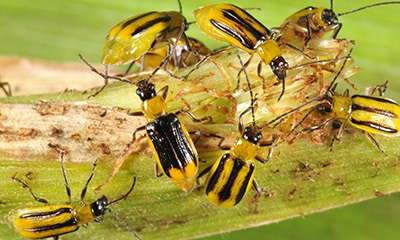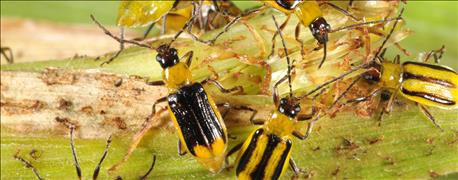March 21, 2016

The Eastern Corn Belt hasn’t faced Bt corn rootworm resistance to the degree that the Midwest has. But the warning signs and risks are already plentiful.

A BUG YOU WON’T WANT TO FIND: Preventive control strategies of western corn rootworm beetles or larvae need to start when first suspected – or ideally before that.
That’s why land-grant university Extension and research entomologists in Indiana, Michigan, Ohio, New York, and Pennsylvania partnered in a response to a 2013 EPA request for a consensus recommendation on preventing the problem. Their consensus was: With the variety of crops grown, smaller fields and more non-farmed areas, crop rotation is the best management tool. That still stands as the top recommendation from Cornell’s Elson Shields, Michigan State’s Chris DiFonzo, Penn State’s John Tooker, Purdue’s Christian Krupke and Ohio State’s Andy Michel.
Preventive strategy must be priority
Confirming Bt resistance in western corn rootworm means gathering and testing a full, overwintering, generation of rootworm. That can take a year, points out DiFonzo. “If it looks like resistance in the field, treat it like resistance. Waiting for a confirmation can be too late. Rotate crops now,” he urges.
Thus far, in Ohio and Indiana, only a few suspect fields have shown up – but no confirmed resistance.
New York has had only one control failure “that looked like the beginnings of resistance,” says Shields. “The field had been 10 years of continuous corn with the same Bt hybrid. The producer rotated crops and the problem has not reappeared or shown up in adjacent fields.”
Michigan experienced a similar situation. A few suspect fields were found in livestock operations growing continuous corn, says DiFonzo. But there was no confirmed resistance, and the producers rotated crops.
In Pennsylvania, Bt control failures have appeared on at least four farms, reports Tooker. Three were in continuous corn fields on dairy farms; the fourth was a grain farm. Two of the failures were adjacent farms in consecutive years, suggesting the resistant adults may have moved between the farms. The problem fields were all rotated to soybeans or alfalfa.
In Midwest areas with a widespread, continuous, two-year rotation of corn and soybeans, some rootworm adults have evolved to lay eggs in adjacent soybean fields. That can make rootworms a problem the next year in first-year corn.
“In a lock-step, two-year rotation, you’re selecting for those individuals that lay their eggs elsewhere. Then, that population becomes the dominant trait, overwhelming rotation,” says Krupke. “It’s a pretty simple adaptation, but a pretty powerful one.”
“For corn rootworm, crop rotation is always, always, No. 1”, emphasizes DiFonzo. “For dairy farms or others who may have to grow continuous corn, at least try to rotate every third year. Don’t grow continuous corn for 10 or 20 years.”
Why rotating Bt proteins isn’t enough
Individual Bt proteins for controlling corn rootworm have been pyramided or stacked with other Bt proteins used to control European corn borer and with genes for herbicide tolerance in various combinations. EPA’s approval of pyramids led to a refuge reduction from 20% to 5%, and approval of refuges-in-the-bag.
“Refuges do help,” notes Michel. “But the lesson is rotation – crop rotation, Bt rotation and using non-Bt hybrids with a soil insecticide.”
~~~PAGE_BREAK_HERE~~~
Using Bt pyramid or BT-stacked hybrids, doesn’t rotate Bt proteins. If you suspect rootworm resistance to a Bt protein and go to a stacked hybrid, “it dramatically increases selection pressure on the other Bt proteins for rootworm,” explains Krupke. “That’s the fastest way to develop resistance.”
“If the insect is resistant to one toxin, it puts a lot of pressure on the second toxin,” adds Shields. “That’s the type of insect resistance they’re starting to see in the Midwest.”
“Pyramiding is a short-term solution,” elaborates DiFonzo. “You’re doubling up on toxins, which may kill more beetles now, but it can create a long-term problem. RIB depends on every toxin in that bag working.”
Lower-cost defense
If you must grow continuous corn, rotate with a non-Bt hybrid, scout to determine thresholds, and use a soil insecticide if needed. “There are enough non-Bt hybrids for growers to get by,” says Krupke. “With low corn prices and the possibility of resistance, growers are considering non-Bt technology.”
But using a soil insecticide with a Bt hybrid isn’t an effective resistance management strategy either. “A soil-applied insecticide only protects brace roots,” explains Shields. The rest of that plant’s root system remains a food source for corn rootworm larvae and continues to select for resistance in the insect population. In fact, it keeps the pressure on for those problems to worsen, and can mask the damaging effect of resistant rootworms. That makes it even harder to assess what’s working and what isn’t.
Speedy identification of a resistant population is very important, stresses Michel. Locate suspect fields quickly and make a plan right away – preferably rotation. “The later you collect adults in a suspect field, the more likely you’re to have adults migrate in, and for the suspect adults to disperse.”
Peterson is a freelancer from St. Johns, Mich.
You May Also Like




